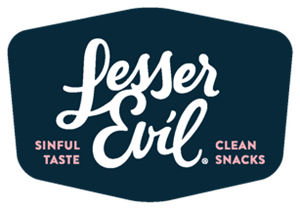LesserEvil Brings in $19M, Reports 40% Bump in Valuation

Snack brand LesserEvil has closed a roughly $19 million capital raise, as it seeks to bet big on single-serve snacking and automation. Of the total raise, $13.5 million will go towards offering early investors liquidity while $5.5 million will go to the company as a primary transaction.
With the company hitting breakeven about six years ago, Charles Coristine, president and CEO of LesserEvil told NOSH “We didn’t need the money.” “We just aren’t sure when we are going to fundraise again and this may potentially be the last time we raise [capital].”
As part of the deal, new investor Aria Growth Partners took a “significant” minority stake in the company, Coristine said, while existing investors Touch Capital and Invest Eco also took part in the round, which closed earlier this year.
Coristine said this is the third time the company has used a funding event to cash out earlier investors and bring new institutional capital on board. With each of these raises, however, the company’s valuation has also gone up. This year’s round comes in at a valuation roughly 40% higher than LesserEvil’s last round, less than a year ago.
“A lot of our investors, I’ve told them ‘I don’t know when I’m going to make a mistake’…and maybe the valuation will cool,” Coristine admitted. “The pressure of having friends and family in your company [is high] and so it takes a lot of that pressure off when you start to get your investors their money back.”
What is the new capital going towards? Hiring, automation and manufacturing processes to enable new pack sizes, Coristine said. LesserEvil has long had a popcorn and puff production plant in Danbury, Connecticut, but next month will bring a second 30,000 square foot facility in New Milford fully online.
The New Milford plant will streamline production of a burgeoning new format for the brand: single serve bags and multipacks, the latter of which was launched less than two years ago.
The company’s current operations have it popping popcorn and filling small bags in Danbury, and then moving it to New Milford, where these smaller bags are manually put into larger multiserve packaging. Once the facility is complete, New Milford will be able to produce its own popcorn and have an automated packing process.
Though snacking certainly isn’t a new concept, Coristine said he believes that the “meal” occasion has only grown over the last few years, especially as younger generations move to smaller, more frequent mini-meals.
“I think multipacks are the future,” Coristine said. “As the world opens up, and people are having more snacking occasions, they’re jamming little bags in their purses and their bags, and they’re taking them everywhere.”
According to Mintel data from earlier this year, over a quarter of consumers report “increased consumption of salty snacks compared to last year,” with Millennials leading the charge at 47% of consumers surveyed. Close behind, Mintel found, is parents (at 46%) which increasingly overlap with the Millennial generation. Looking at categories of salty snacks, popcorn grew 7% year-over-year.
Multipacks have brought out both new consumers and retailers.
Over the last two years the company has seen distribution gains in mass and conventional channels, with Coristine pointing to Walmart and Target as examples. The draw for these retailers, he added, is its ability to offer multipacks with customizable unit counts. LesserEvil has a 6% ACV for its multipack in MULO (35% in the natural channel), compared to an over 50% ACV (or 89% in natural) for its larger popcorn format.
Still, there’s plenty of competition. In 2023 alone, brands including Ready. Set. Food! Siete and G Fuel have all launched new puff options. In popcorn, LesserEvil competes against bigger players, including Hershey’s backed Skinny Pop, which acquired its copacker earlier this year in an attempt to firm up its own supply chain and drop manufacturing costs.
The company does have other product types in puffs, cheeseballs, toddler snacks, and “Sunpoppers,” with a revenue split of 80% popcorn and 20% puffs. While puffs used to carry a higher percentage of revenue, Coristine said he feels the puffs category is oversaturated and given popcorn is seeing the greatest pickup by retailers, the snack offers LesserEvil “the biggest bang for the buck.”
No matter how many retailers the company adds though, Coristine said, ultimately LesserEvil’s success in the market will come down to pricing.
“As a brand, we want to offer organic, functional oil snacks at the same price as our competitors and the only way we’re going to do that is if we invest in vertical integration and efficiency,” he said. “And that’s how we’re winning.”
















